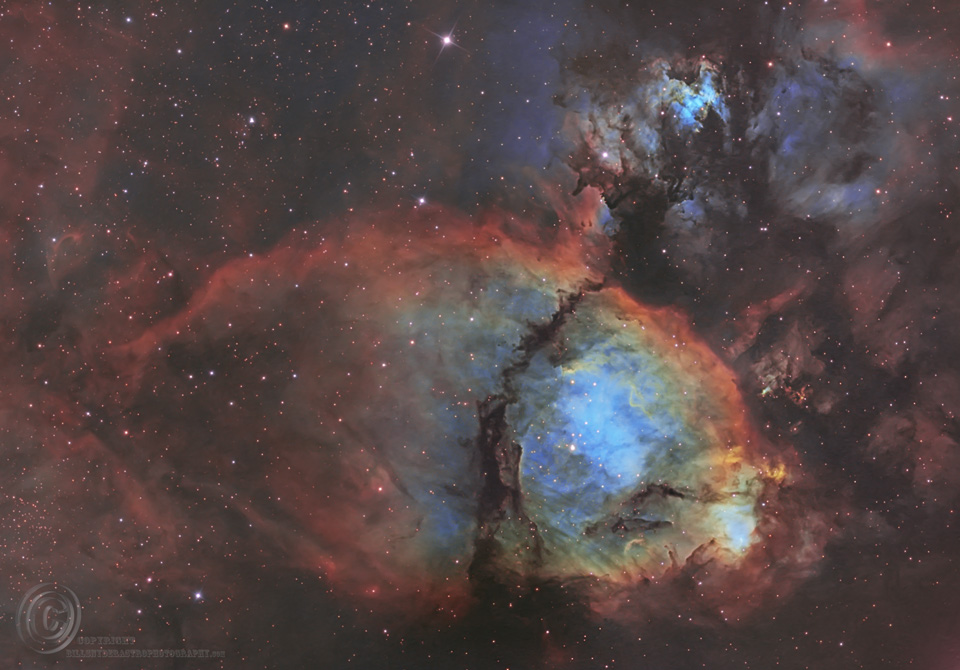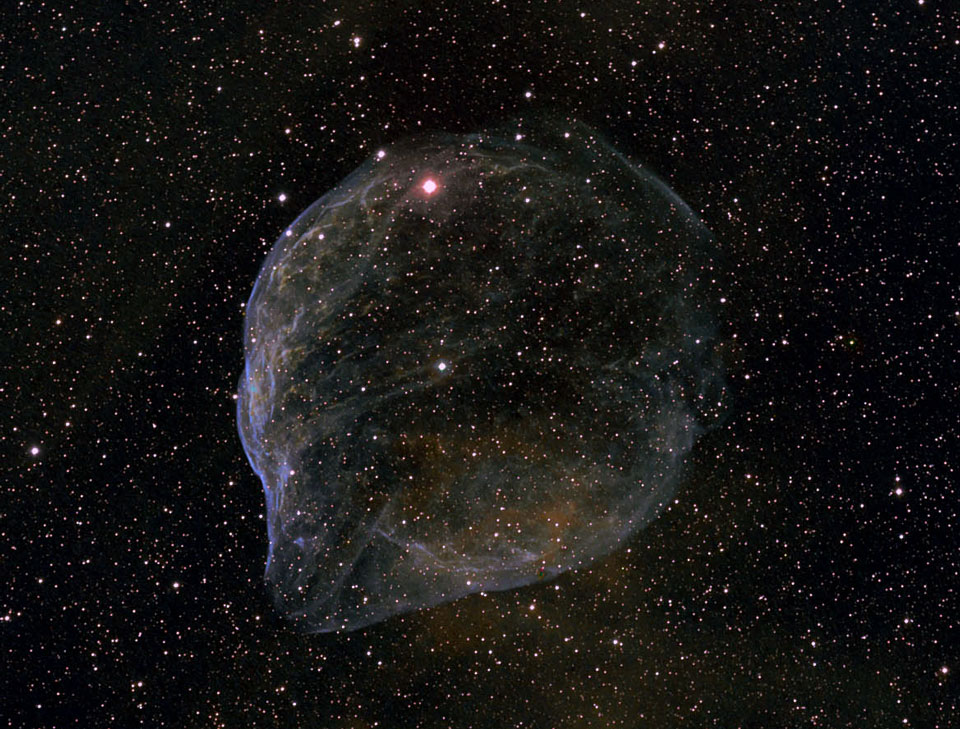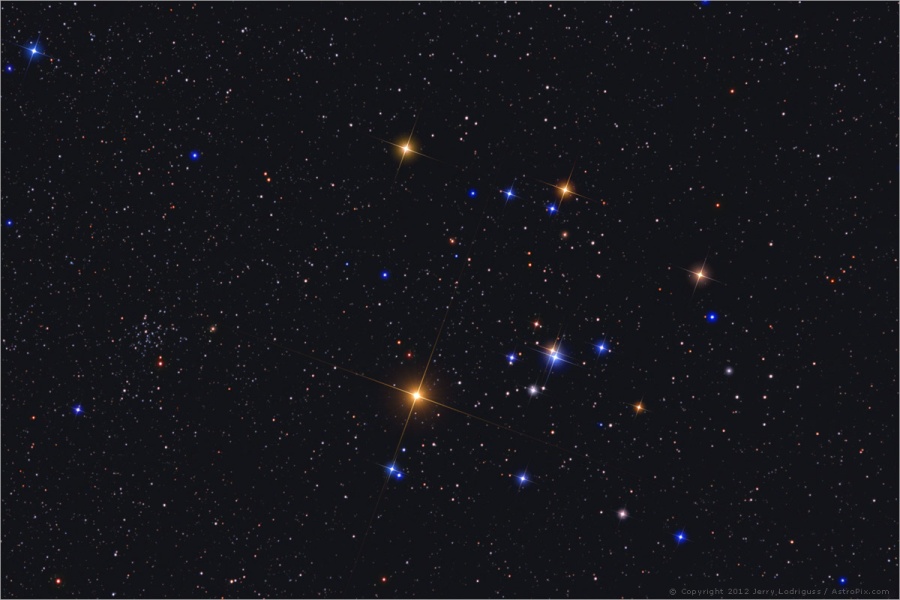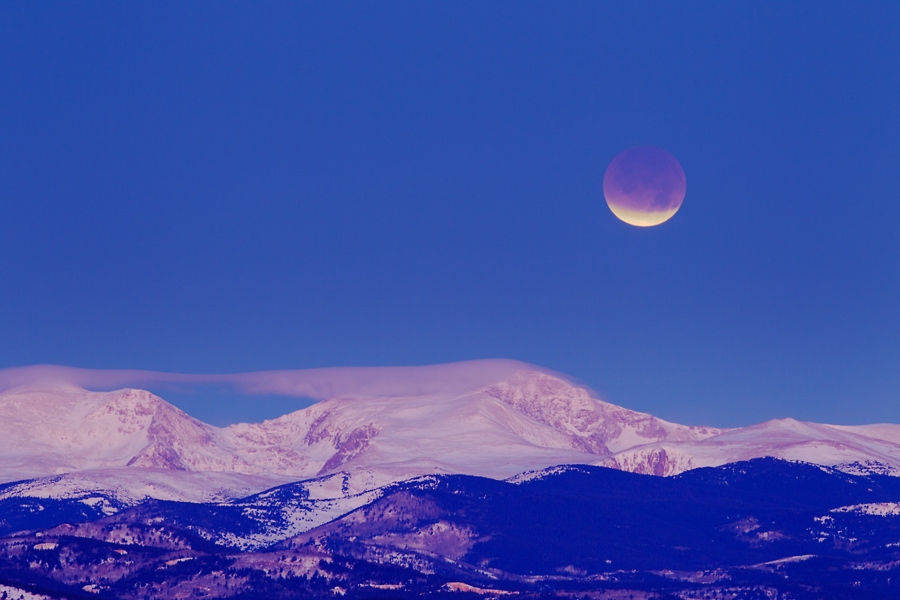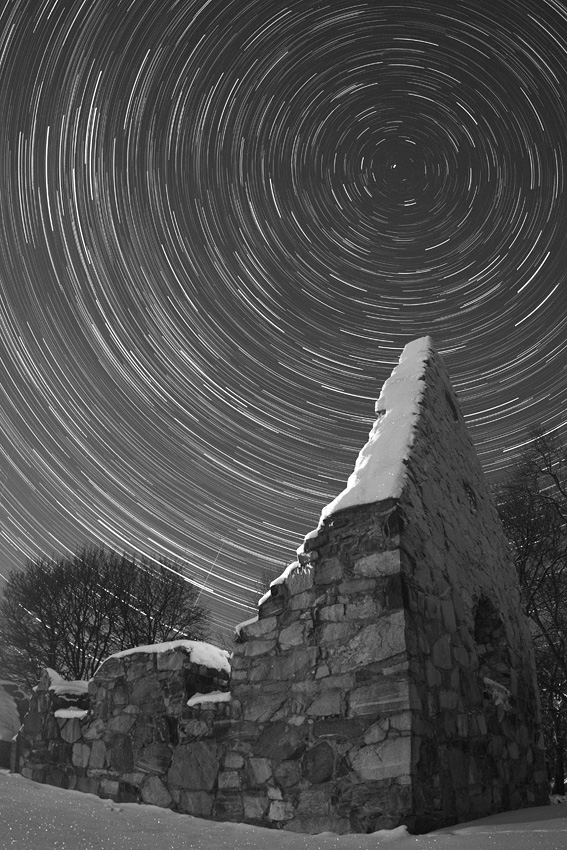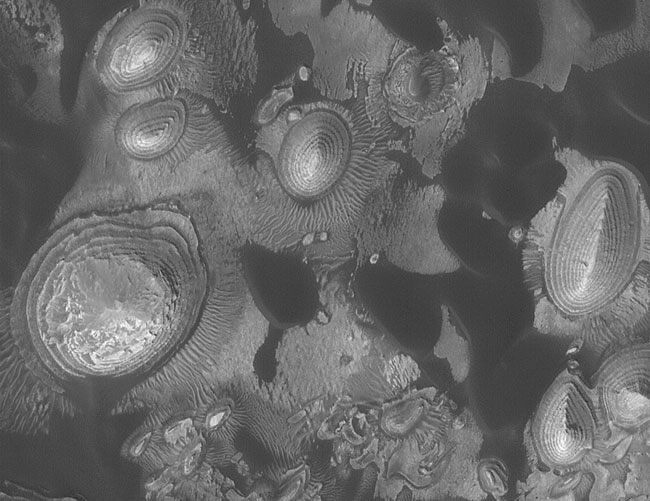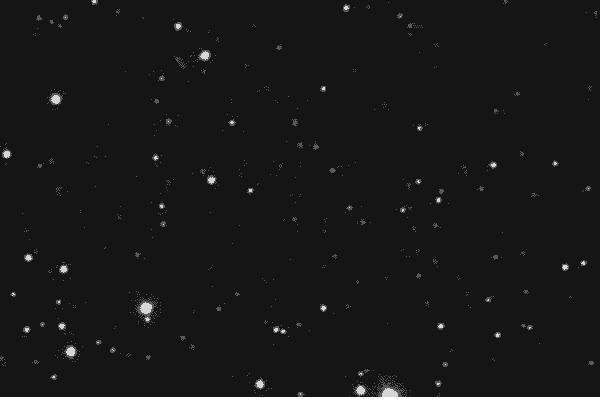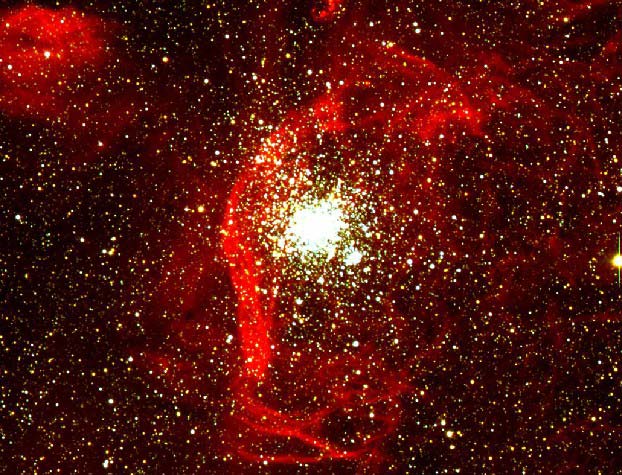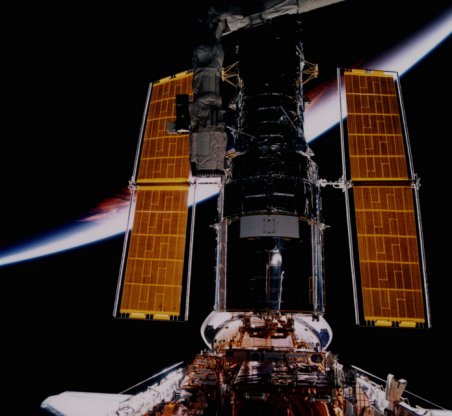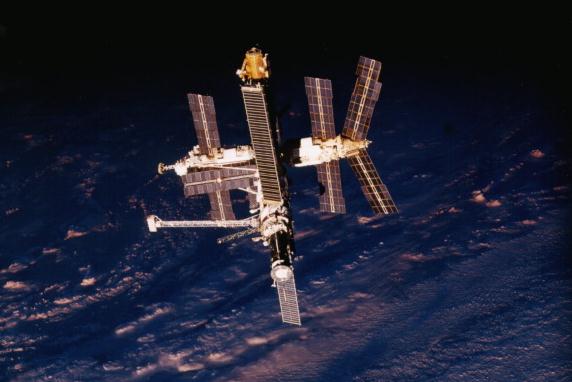| << Previous | Index | Next >> |
2014 To some, this nebula looks like the head of a fish. However, this colorful cosmic portrait really features glowing gas and obscuring dust clouds in IC 1795, a star forming region in the northern constellation Cassiopeia. The nebula's colors were created by adopting the Hubble false-color palette for mapping narrow emission from oxygen, hydrogen, and sulfur atoms to blue, green and red colors, and further blending the data with images of the region recorded through broadband filters. Not far on the sky from the famous Double Star Cluster in Perseus, IC 1795 is itself located next to IC 1805, the Heart Nebula, as part of a complex of star forming regions that lie at the edge of a large molecular cloud. Located just over 6,000 light-years away, the larger star forming complex sprawls along the Perseus spiral arm of our Milky Way Galaxy. At that distance, this picture would span about 70 light-years across IC 1795.
2013 Blown by fast winds from a hot, massive star, this cosmic bubble is huge. Cataloged as Sharpless 2-308 it lies some 5,200 light-years away toward the constellation of the Big Dog (Canis Major) and covers slightly more of the sky than a Full Moon. That corresponds to a diameter of 60 light-years at its estimated distance. The massive star that created the bubble, a Wolf-Rayet star, is the bright one near the center of the nebula. Wolf-Rayet stars have over 20 times the mass of the Sun and are thought to be in a brief, pre-supernova phase of massive star evolution. Fast winds from this Wolf-Rayet star create the bubble-shaped nebula as they sweep up slower moving material from an earlier phase of evolution. The windblown nebula has an age of about 70,000 years. Relatively faint emission captured in the expansive image is dominated by the glow of ionized oxygen atoms mapped to violet hues.
2012 Recognized since antiquity and depicted on the shield of Achilles according to Homer, stars of the Hyades cluster form the head of the constellation Taurus the Bull. Their general V-shape is anchored by Aldebaran, the eye of the Bull and by far the constellation's brightest star. Yellowish in appearance, red giant Aldebaran is not a Hyades cluster member, though. Modern astronomy puts the Hyades cluster 151 light-years away making it the nearest established open star cluster, while Aldebaran lies at less than half that distance, along the same line-of-sight. Along with colorful Hyades stars, this stellar holiday portrait locates Aldebaran just below center, as well as another open star cluster in Taurus, NGC 1647 at the left, some 2,000 light-years or more in the background. Just slide your cursor over the image to identify the stars. The central Hyades stars are spread out over about 15 light-years. Formed some 800 million years ago, the Hyades star cluster may share a common origin with M44 (Praesepe), a naked-eye open star cluster in Cancer, based on M44's motion through space and remarkably similar age.
2011 December's lunar eclipse graced early morning skies over the Rocky Mountains in Colorado, USA. There, this wintry scene finds the Moon in a cold blue twilight sky near the western horizon, above the snowy North American Continental Divide. About 22 minutes before the sunrise, the reddened lunar disk is almost completely immersed in Earth's dark shadow. This dramatic Rocky Mountain moon set during the eclipse total phase. But all parts of the geocentric celestial event were seen from Pacific regions, Asia, and Australia, including the entire 51 minutes of totality, and parts of the final eclipse of 2011 were shared in skies around much of planet Earth.
2010 Pointing skyward, the wall of this ruined Viking church still stands after a thousand winters, near the town of Vallentuna, Sweden. The time exposure records the scene on December 14th as stars leave graceful arcing trails during a long night, reflecting planet Earth's daily rotation on its axis. The Earth's axis points toward Polaris, the North Star, near the center of the concentric trails. Welcomed by skygazers on this winter's night, a bright meteor from the annual Geminid meteor shower also flashes through the frame. The meteor cuts across the star trails just above the lower church wall. Contributing to the beautiful composition, meteor streak and church apex both gesture toward the North Celestial Pole.
2009 Gamma Cassiopeiae shines high in northern autumn evening skies. The brightest spiky star in this rich and colorful Milky Way starfield, bluish Gamma Cas marks the central peak in the W-shaped constellation Cassiopeia. A hot, variable, and rapidly rotating star about 600 light-years distant, Gamma Cas also ionizes surrounding interstellar material, including the wispy IC 63 (left) and IC 59 emission and reflection nebulae. The two faint nebulae are physically close to Gamma Cas, separated from the star by only a few light-years. This well-composed, wide-field view of the region spans almost 2 degrees on the sky.
2008 Forty years ago, in December of 1968, the Apollo 8 crew flew from the Earth to the Moon and back again. Frank Borman, James Lovell, and William Anders were launched atop a Saturn V rocket on December 21, circled the Moon ten times in their command module, and returned to Earth on December 27. The Apollo 8 mission's impressive list of firsts includes: the first humans to journey to the Earth's Moon, the first to fly using the Saturn V rocket, and the first to photograph the Earth from deep space. As the Apollo 8 command module rounded the farside of the Moon, the crew could look toward the lunar horizon and see the Earth appear to rise, due to their spacecraft's orbital motion. Their famous picture of a distant blue Earth above the Moon's limb was a marvelous gift to the world.
2007 Sprawling across hundreds of light-years, emission nebula IC 1396 mixes glowing cosmic gas and dark dust clouds. Stars are forming in this area, only about 3,000 light-years from Earth. This detailed view was created in light primarily emitted by hydrogen gas, recorded through a filter that narrowly transmits a wavelength characteristic of glowing hydrogen atoms in the nebula. Among the intriguing dark shapes within IC 1396, the winding Elephant's Trunk nebula lies just left center. IC 1396 lies in the high and far off constellation of Cepheus.
2006 Eight years ago results were first presented indicating that most of the energy in our universe is not in stars or galaxies but is tied to space itself. In the language of cosmologists, a large cosmological constant is directly implied by new distant supernovae observations. Suggestions of a cosmological constant (lambda) are not new -- they have existed since the advent of modern relativistic cosmology. Such claims were not usually popular with astronomers, though, because lambda is so unlike known universe components, because lambda's value appeared limited by other observations, and because less-strange cosmologies without lambda had previously done well in explaining the data. What is noteworthy here is the seemingly direct and reliable method of the observations and the good reputations of the scientists conducting the investigations. Over the past eight years, independent teams of astronomers have continued to accumulate data that appears to confirm the unsettling result. The above picture of a supernova that occurred in 1994 on the outskirts of a spiral galaxy was taken by one of these collaborations.
2005 In December of 1968, the Apollo 8 crew flew from the Earth to the Moon and back again. Frank Borman, James Lovell, and William Anders were launched atop a Saturn V rocket on December 21, circled the Moon ten times in their command module, and returned to Earth on December 27. The Apollo 8 mission's impressive list of firsts includes: the first humans to journey to the Earth's Moon, the first manned flight using the Saturn V, and the first to photograph the Earth from deep space. As the Apollo 8 command module rounded the farside of the Moon, the crew could look toward the lunar horizon and see the Earth appear to rise, due to their spacecraft's orbital motion. The famous picture that resulted, of a distant blue Earth above the Moon's limb, was a marvelous gift to the world.
2004 A forward-facing RocketCam (TM) mounted inside the payload fairing of a Delta II rocket captured these dramatic video frames on November 20th -- as the Swift satellite observatory journeyed to an orbit 600 kilometers above planet Earth. Some frames were interpolated to correct for transmission problems. The sequence shows the fairing separation, the second stage rotating past the Earth's limb, and finally the 1500 kilogram satellite itself separating from the second stage. Observing at optical, ultraviolet, x-ray and gamma-ray energies, Swift is designed to locate the sources of energetic gamma-ray bursts and watch as their afterglows fade in the distant Universe. Still in its checkout phase, the observatory is already detecting the high energy flashes from these awe-inspiring cosmic blasts.
2003 Why are some hills on Mars so layered? The answer is still under investigation. Clearly, dark windblown sand surrounds outcropping of light sedimentary rock across the floor of crater Arabia Terra. The light rock clearly appears structured into many layers, the lowest of which is likely very old. Although the dark sand forms dunes, rippled dunes of lighter colored sand are easier to see surrounding the stepped mesas. Blown sand possibly itself eroded once-larger mesas into the layered hills. Most of the layered shelves are wide enough to drive a truck around. The above image, showing an area about 3 kilometers across, was taken in October by the Mars Global Surveyor spacecraft currently orbiting Mars. Tomorrow, the first of three robot spacecraft from Earth is scheduled to arrive at the red planet.
2002 Spring reached the north pole of Mars in May, and brought with it the usual dust storms. As the north polar cap begins to thaw, a temperature difference occurs between the cold frost region and recently thawed surface, resulting in swirling winds between the adjacent regions. In the above image mosaic from the Mars Global Surveyor spacecraft currently orbiting Mars, the white material is frozen carbon dioxide that covers much of the extreme north. The choppy clouds of at least three dust storms can be identified.
2001 Last week, an asteroid approached unusually close to the Earth. Passing well outside the orbit of our Moon, Asteroid 1998 WT24 posed no danger, but became bright enough to see with binoculars and to track with radar. Pictured above, the kilometer-sized asteroid was imaged crossing the sky on December 14, two days before closest approach. Every few years, an asteroid will actually pass inside the orbit of the Moon. Large impact features on the Earth are testaments to asteroids or comets that actually impacted the Earth in the distant past. Astronomers continue to discover, track, and study potentially hazardous asteroids with a goal of making planet Earth a safer place.
2000 There's nothing like it in our own Galaxy. Globular clusters as young as NGC 1850 don't exist here. Globular clusters only 40 millions of years old can still be found in the neighboring LMC galaxy, though, but perhaps none so unusual as NGC 1850. Close inspection of the above photograph will reveal two clusters. Below and right of the main group of stars known as NGC 1850A is a smaller, still younger group dubbed NGC 1850B. This cluster is made of stars only about four million years old. The large red cloud of gas surrounding the clusters may have been predominantly created by supernovae explosions of stars in the younger cluster. The red supernova remnant N57D is visible on the upper left.
1999 How would you like to spend your holiday in low earth orbit? That's what the crew of the space shuttle Discovery is doing as they deliver six new gyros and a faster main computer to the orbiting Hubble Space Telescope. The telescope has been holding in safe mode since November 13 and will use the timely "gifts" to resume its exploration of the distant Universe. This mission, STS-103, is the third mission to service the famous space observatory which was placed in orbit by Discovery on April 25, 1990. Seen here in a 1997 picture from STS-82, the second servicing mission, the space telescope, flanked by its gold-colored solar panels, hangs above the shuttle payload bay. The Earth's bright limb is in the background. Discovery closed with the Hubble on Tuesday and crew members are conducting space walks to install the new equipment. Discovery is scheduled to return to Earth after Christmas, with a December 27 landing at Kennedy Space Center - but you can e-mail season's greetings to the orbiting crew.
1998
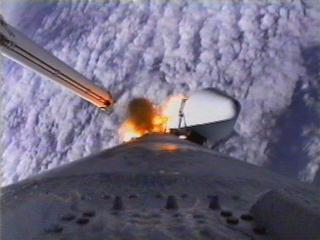

Credit: Courtesy NASA
1997 30 Doradus is lit up like a Christmas tree. Shining in light across the electromagnetic spectrum, 30 Doradus glows because of all the energetic processes that go on there. A distinctive region visible in a Milky Way satellite galaxy called the Large Magellanic Cloud (LMC), 30 Doradus is a hotbed of star formation, supernova explosions, and ionized plasma. The above image is a composite of three pictures taken in three different wavelength bands of light. Red represents X-ray emission created by gas as hot as 1 million degrees Kelvin. Green represents emission from ionized hydrogen gas, and blue represents ultraviolet radiation primarily emitted by hot stars. At the conclusion of this symphony of star formation and light in a few million years, astronomers expect that a new globular cluster will have formed.
1996 Thinking about spending the Holiday Season in low Earth orbit? Astronaut John Blaha and his cosmonaut colleagues Valeri Korzun and Alexander Kaleri are doing just that onboard the Russian Mir spacestation. You can e-mail them Seasons Greetings. Blaha replaced Shanon Lucid as a Mir resident during the STS-79 mission flown by the Space Shuttle Atlantis and is scheduled to be replaced by Jerry Linenger when Atlantis makes another shuttle run to Mir during the STS-81 mission. The Mir is seen here 200 miles above the Earth as the sun sets following the latest Atlantis undocking. NASA shuttle flights to the Mir are part of the Phase 1 program for construction of the International Space Station.
1995 NASA's robot spacecraft Voyager 2 passed the planet Uranus and its moons in 1986. While the cloud tops of Uranus proved to be rather featureless, the surface of Miranda, the innermost of Uranus' large moons, showed several interesting features. Voyager 2 passed closer to Miranda than to any Solar System body and hence photographed it with the clearest resolution. Miranda's heavily cratered terrain shows grooves like Jupiter's moon Ganymede and several valleys and cliffs. Miranda is made of a roughly equal mix of ice and rock. Miranda was discovered by Gerard Kuiper in 1948.
| << Previous | Index | Next >> |
